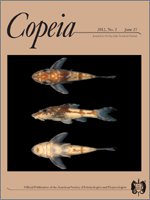Organisms that are distributed across spatial climate gradients often exhibit adaptive local variations in morphological and physiological traits, but to what extent such gradients shape evolutionary responses is still unclear. Given the strong natural contrast in latitudinal temperature gradients between the North-American Pacific and Atlantic coast, we asked how increases in vertebral number (VN, known as Jordan's Rule) with latitude would differ between Pacific (Atherinops affinis) and Atlantic Silversides (Menidia menidia), two ecologically equivalent and taxonomically similar fishes with similar latitudinal distributions. VN was determined from radiographs of wild-caught adults (genetic environmental differences) and its genetic basis confirmed by rearing offspring in common garden experiments. Compared to published data on VN variation in M. menidia (a mean increase of 7.0 vertebrae from 32 to 46°N, VN slope = 0.42 lat−1), the latitudinal VN increase in Pacific Silversides was approximately half as strong (a mean increase of 3.3 vertebrae from 28 to 43°N, VN slope = 0.23 lat−1). This mimicked the strong Atlantic (1.11°C lat−1) versus weak Pacific latitudinal gradient (0.40°C lat−1) in median annual sea surface temperature (SST). Importantly, the relationship of VN to SST was not significantly different between the two species (average slope = −0.39 vertebrae °C−1), thus suggesting a common thermal dependency of VN in silverside fishes. Our findings provide novel support for the hypothesis that temperature gradients are the ultimate cause of Jordan's Rule, even though its exact adaptive significance remains speculative. A second investigated trait, the mode of sex determination in Atlantic versus Pacific Silversides, revealed patterns that were inconsistent with our expectation: M. menidia displays temperature-dependent sex determination (TSD) at low latitudes, where growing seasons are long or unconstrained, but also a gradual shift to genetic sex determination (GSD) with increasing latitude due to more and more curtailed growing seasons. Sex ratios in A. affinis, on the other hand, were independent of latitude and rearing temperature (indicating GSD), even though growing seasons are thermally unconstrained across most of the geographical distribution of A. affinis. This suggests that additional factors (e.g., longevity) play an important role in shaping the mode of sex determination in silverside fishes.
How to translate text using browser tools
27 June 2012
Contrasting Latitudinal Variations in Vertebral Number and Sex Determination in Pacific Versus Atlantic Silverside Fishes
Hannes Baumann,
Jorge A. Rosales Casián,
David O. Conover
ACCESS THE FULL ARTICLE





